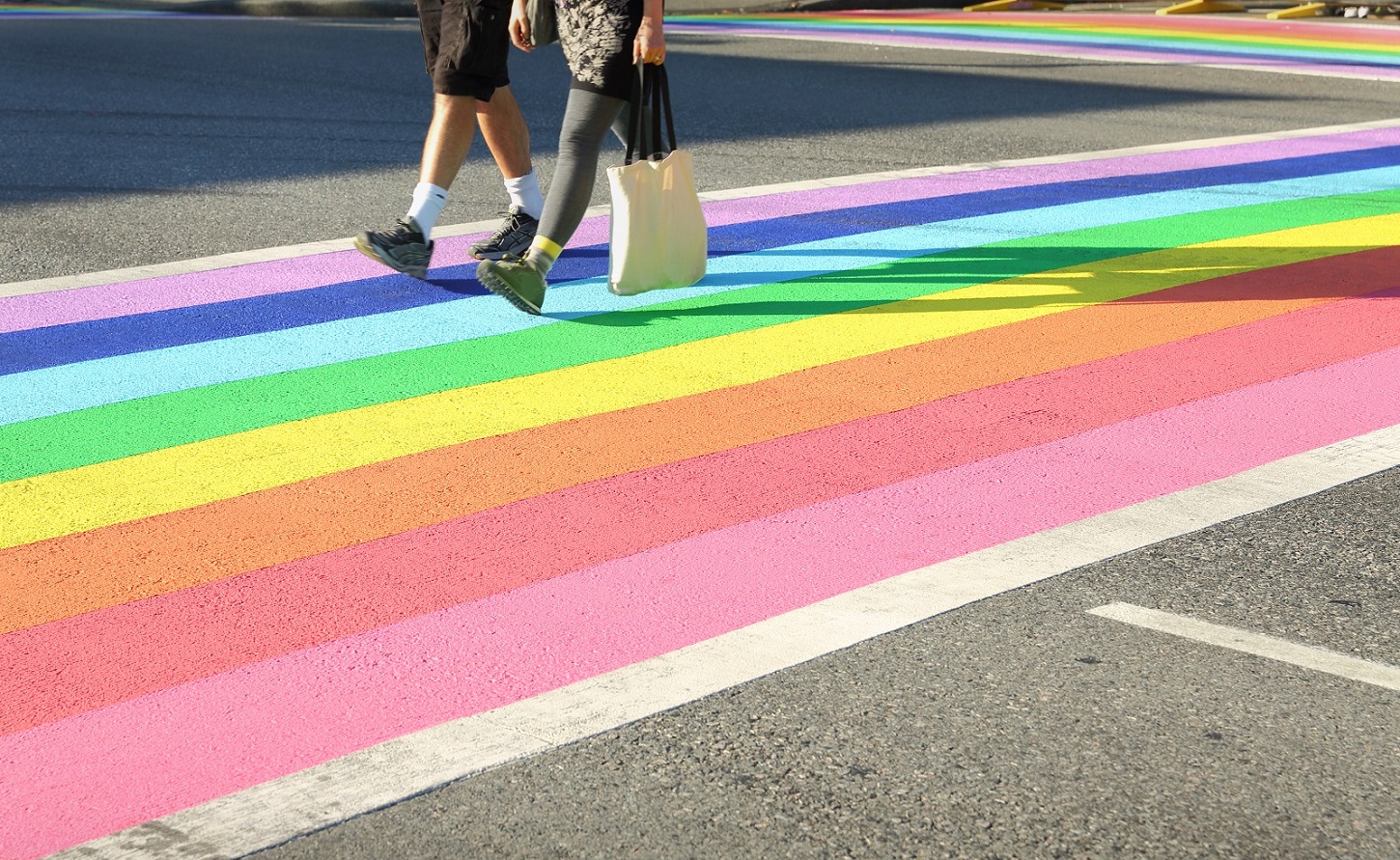This Month — and All Year

Subscribe to Catalyst
Subscribe to get our magazine delivered right to your inbox
Related Articles
Subscribe to Catalyst
Subscribe to get our magazine delivered right to your inbox
Related Articles
It’s Pride Month! These celebratory events — signature weeks and months, T-shirt days, and other public acknowledgments — provide visibility and a sense of collectivity. Let’s not let the colours fade when the calendar changes.
We skipped toward the main drag with our extended family for some quality time after months apart because of pandemic isolation orders. It was nice to be off screens and among people as we took in the sights on a Sunday in small-town Ontario. This day had all the check marks: great weather, ice cream stands, antique shops, people picnicking, and traffic that halted for jaywalkers zigzagging from shop to shop. At the strip’s entrance was a rainbow crosswalk, providing a highlight for pedestrians entering the busy thoroughfare, and visibility of another kind. Pride crosswalks are designed to promote inclusion and awareness of 2SLGBTQ+ communities, and they range from six-colour rows to chevroned designs that underscore intersecting identities.
Like a lot of municipal infrastructure, this particular project needed an update after a few years of wear and tear. The chipped paint seemed like a bit of handy symbolism as I reflected on Pride Month and many symbolic days and months that bring people together around an issue and idea — which sometimes fade away when the calendar page flips.
The well-being of people with diverse gender identities can be greatly affected by the characteristics, norms, practices, and spaces of our institutional environments. This is reflected in the things we see and the actions we take. —
On this day
“I’m Black all year,” a friend likes to quip as we head into February and she bemoans the litany of requests for very visible speaking engagements, which arrive in the weeks before Black History Month, while offers for secure and steady paid work in her field never materialize. When you experience the gap between a passing visibility and the very real inability to provide for yourself, acknowledgment months can sometimes feel like window dressing. I suppose that’s part of the risk of putting a lot of energy into special months or T-shirt days. But it might also lead us to ask ourselves what contribution is being made. Is it a surface effort? A small step toward systemic change? I’m not ready to write off these events just yet — though their snapshot effect may obscure the complexity of the lived and living experiences in the communities being recognized.
The tagline for GLADD, the American media advocacy organization, says that it “rewrites the script for LGBTQ acceptance.” Its Pride Month Resource Kit for journalists takes a huge step toward this by highlighting some of the pitfalls and assumptions telegraphed through footage and images in Pride events coverage. “No single image should be put forth as representative of either the LGBT community or the range of events that occur at Prides,” it counsels, noting that “colorful and unconventional participants play an important role at Pride events and celebrations.” GLAAD encourages journalists to “avoid the tendency to ignore the diversity that exists at Pride events,” since relying on “outrageous or over-the-top images and footage marginalizes subjects by taking them out of context to depict them as abnormal — perpetuating misconceptions.”
These suggestions bring to mind the drag parade float images of past coverage and lead me to realize how such things can become visual shorthand for progressive movements that are dynamic and complex. Such movements can also quickly become co-opted from their origins in social change. Recent protests to counter “rainbow-washing” — supporting anti-2SLGBTQ+ interests while claiming public allyship with 2SLGBTQ+ communities — have emerged alongside calls to extend Pride initiatives beyond one month, particularly in remote communities.
Representation matters
The well-being of people with diverse gender identities can be greatly affected by the characteristics, norms, practices, and spaces of our institutional environments. This is reflected in the things we see and the actions we take. For the Catalyst, the Mental Health Commission of Canada’s (MHCC’s) online magazine, this means avoiding oversimplification in our storytelling while emphasizing recovery and optimism. We want to offer hope, but not false hope — and no single, tightly construed narratives. In other words, we believe it’s important to recognize the both-and in any given experience — a perspective illustrated in recent COVID-19 research. New Leger polling for the MHCC and the Canadian Centre on Substance Use and Addiction shows that 2SLGBTQ+ communities have faced heightened rates of stigma, discrimination, and harassment during the pandemic yet were also feeling more resilient, hopeful, accepting, and inclusive.
The poll’s other findings reflect a similar complexity. While about one-quarter of 2SLGBTQ+ respondents reported excellent or very good mental health during the pandemic, rates were significantly lower for 2SLGBTQ+ youth, people from low-income households, and those from East and Southeast Asian, South Asian, and African, Caribbean, and Black (ACB) communities. This same pattern was found in connection with the stresses of COVID-19. Though only half of 2SLGBTQ+ respondents reported being able to cope with pandemic stress, fewer 2SLGBTQ+ youth and ACB respondents could do so.
On an individual level, we also have a chance during Pride Month to reflect on its evolution and what it means for Indigenous communities. As well, we might consider why something so seemingly simple as crosswalks are being subjected to defacing and vandalism, thus reducing the visibility of that quiet sign of support. In context of the pandemic, Pride can be a chance to build networks to support 2SLGBTQ+ youth and racialized communities, who are contending more than most with overlapping crises, by being an ally throughout the year.




